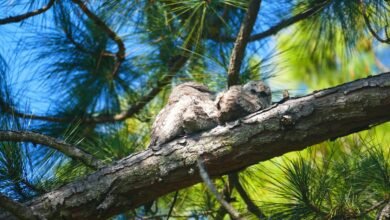The nest

Most humans live apart from natural environments and fail to see what is happening, not just in terms of their destruction but in terms of how they work. To take one example: Marx thought it was labour (not soul or rationality or consciousness that distinguishes humans from animals) but I watch these two firetails work so hard and cleverly above my head. Imagine making a nest without opposable thumbs or fingers. Marx had no idea.
Nests are so unlike cars, hotels, cathedrals, they are deft, temporary, use recycled materials and just take the time they need.
Birds are not the only animals to make a nest; fishes, mammals, insects and spiders also build nests, sometimes quite complex ones, for rearing young and for their own general protection. Great apes build a new nest every night to sleep. In our search for a home, a burrow, a nest, we have shut the door on nature, and in our search for comfort, luxuries have become necessities and we have (all) become gross consumers.
‘A nest – and this we understand right away – is a precarious thing, and yet it sets us to daydreaming of security.’ Gaston Bachelard.
Bachelard was a dreamy French philosopher, his The Poetics of Space is unreasonably nostalgic but he expresses a reverence for nests, many of us feel: ‘[T]he living nests . . . found in natural surroundings becomes for a moment the center – the term is no exaggeration –of an entire universe.’ He meditates on a nest worrying its precarious existence and then thinks of home as protection for the family in a dangerous environment.
Much of the danger is insidious – take the clock. Franco Piperno argues that when clocks replaced techne and the body had ‘the bewildering experience of being synchronized with the rhythm of the machine; the time of the machine builds a nest in the body of the worker.’
‘I have learned to appreciate how reverie authors a solitude which allows one to contemplate the world ‘without counting the minutes’.’ Bachelard Clocks prevent reverie which Bachelard thought eases anxiety and ennui by helping us ‘to escape from the rigidity of mental habits formed by contact with familiar experiences.’
I am much more interested in paying attention to the environment. John Clare attacked Keats for writing second-hand descriptions of nature.
Aye here it is stuck close beside the bank . . .
Lined thinly with the horses sable hair
– Five eggs pen-scribbled over lilac shells
Resembling writing scrawls which fancy reads
As natures poesy and pastoral spells
They are the yellow hammers . . ‘The Yellowhammers Nest’
Robert Pogue Harrison writes of Clare: ‘All his life he had written about nests — “The Moorhens Nest,” “The Robins Nest,” … Nest,” “The Yellowhammers Nest,” “The Pettichaps Nest,” “Wild Bees’ Nest,” “The … Nests for Clare were tiny miracles. They were places of safety.’
I find nests beautiful for their fragility and material form, though many birds in Jagun nest in the termite mounds and not far away, eagle and ospreys build large unwieldy nests up high.

There is a Friarbird’s nest high in these trees. All you can see through binoculars is this strange black bill sticking out from a lovely round orange-coloured nest.
Refs:
Gaston Bachelard, ‘Nests’ in The Poetics of Space, (1958) Boston: Beacon Press, 1994
Franco Piperno, ‘Technological Innovation and Sentimental Education’ in Radical Thought in Italy: A Potential Politics, Eds. Paolo Virno and Michael Hardt, Minneapolis: U of Minnesota P, 1996.
Gaston Bachelard, The Poetics of Reverie . . . (1969) Daniel Russell, Trans. Boston: Beacon Press, 1971, p173
Gaston Bachelard, The Psychoanalysis of Fire, trans. Alan C. M. Ross, Boston: Beacon Press, 1964, p4.
Robert Pogue Harrison, Forests: the shadow of civilization, 1993.



